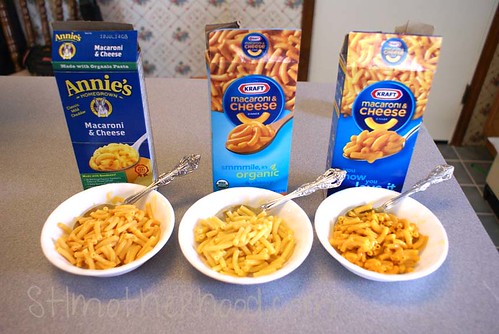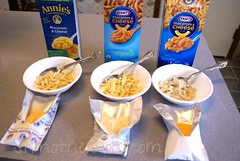 There’s been a lot of talk about Kraft putting artificial dyes Yellow #5 and Yellow #6 in their Kraft Mac and Cheese. A few bloggers started an online petition to get Kraft to remove the dye from its Mac and Cheese saying that it can cause cancer and make your kids hyper.
There’s been a lot of talk about Kraft putting artificial dyes Yellow #5 and Yellow #6 in their Kraft Mac and Cheese. A few bloggers started an online petition to get Kraft to remove the dye from its Mac and Cheese saying that it can cause cancer and make your kids hyper.
As we noted last time, Kraft says the dye is federally approved and perfectly safe.
While the bloggers compared Kraft Mac & Cheese to it’s dye-free British counterpart (Kraft Cheesy Pasta) I pointed out that dye-free macaroni is available right now.
This afternoon I cooked up three boxes of macaroni: Kraft original, Kraft Organic and Annie’s Macaroni and Cheese. I wanted to see for myself if there’s really a big difference in color–and taste. Kraft Organic and Annie’s don’t use Yellow #5 and #6.
The first thing I noticed was the color of the raw noodles–the original Mac & Cheese was pale while both organics (which used a whole grain pasta) were more buttery colored. The color difference in the cheese packets were obvious. Original Kraft has a bright orange hue, Organic Kraft is very bland and Annie’s was pale gold.
In order to give the pastas the best chances of a similar taste I used real butter and 2% milk to mix up all three.
The results were what you would expect–after all Kraft knows their stuff. My 5 year old said the pale yellow Organic Kraft looked yucky, but he said the Annie’s orange noodles looked just as good as the Original Kraft. But after tasting them, he said they were all good.
My 14 year old, who has considerably more experience with Mac & Cheese, said he liked the Original Kraft best for color and flavor. I believe his remark was “government approved chemicals taste good!” Smart arse.
After I tasted all three, I have to say the Kraft Original was still the best for flavor. Color doesn’t matter to a grown up. Both the Annie’s and the Organic Kraft were bland and buttery in taste. Which is not the same as cheap–have you ever had a box of no-name mac & cheese? Ewww. These weren’t bad, just not as good. If you put it on a plate next to your fish sticks one night, you’d be happy. But the Kraft Original was the only one with a tangy kick to it.
A Note on cheese color:
I have no idea why Kraft makes their Mac & Cheese bright orange. BUT I did do a little research and I can tell you the natural color of cheese depends on the kind of grass cows eat. According to this article on Slate if a cow grazes on rich summer grass they give milk that turns cheese into a deeper yellow color. A poor diet results in less fat in the milk, less fat makes pale cheese. English farmers had this figured out waaaaaay back in the 16th century and added carrot juice or marigold petals to perk up the color of cheese.
The Cheese Underground reports that cheese makers in Wisconsin started coloring cheddar with Annatto seeds in the 18th century. It seems that once farmers started feeding corn to their cows instead of grass, the milk produced a pale cheese. As a bonus, the orange cheese was easy for customers to spot compared to pale yellow New York cheese.
It would seem cheese color has always been about marketing!
